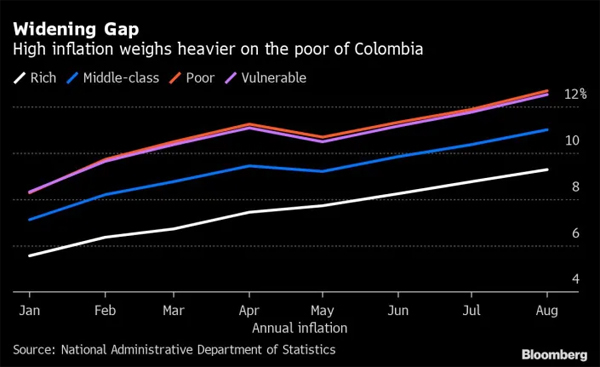
Maria Eloisa Capurro, Matthew Bristow and Maya Averbuch, Bloomberg News
BRASILIA/BOGOTA/MEXICO CITY
EnergiesNet.com 09 13 2022
Governments globally are coming under immense pressure to cushion the blow of surging food and fuel prices. In Latin America, the response risks igniting a tinderbox.
From Mexico to Brazil, persistent high inflation is widening the gap between rich and poor in what is already the world’s most unequal region. It’s stoking political upheaval that could be a foretaste of what lies ahead as policy makers the world over struggle to meet demands to increase social spending.
Across Latin America, a burgeoning middle-class is seeing its prospects eroded. For society’s poorest, the latest wave of consumer price increases will be a full percentage point higher than for the richest, estimates by the Economic Commission for Latin America and the Caribbean (Eclac) show. One third of the entire region is poised to meet the criteria for poverty, defined as those living on $1.90 a day.
Evidence that the impact is weighing most heavily on the poorest is already bubbling over into social unrest.
In Panama, protestors blocking highways and ports prompted a freeze in the prices of 72 essential goods in July. Strikes in Peru the same month forced a pledge of more state help for the poor. Ecuador’s government is in talks with indigenous organizations after rioting broke out over the soaring cost of living. A common refrain is that only the rich can now afford even basic foodstuffs.
Interest rate rises of 250 basis points or more this year in at least seven of the region’s nations have yet to make much of a difference, leaving governments to deploy tax cuts and social programs at the expense of fragile public finances.
Yet throwing money at the problem could backfire, weighing on currencies and further driving up food prices, according to Adriana Dupita, Latin America economist with Bloomberg Economics.
“Latin American leaders are struggling to soothe the population’s anguish about prices with the tools they have at hand,” she said.
Voters in Peru, Chile and Colombia have all opted for radical change in the past 18 months, as the pandemic focused anger over longstanding inequalities. Rampant inflation as supply-chain disruptions collide with Russia’s invasion of Ukraine is compounding those grievances.
“This round of inflation is even more harmful for poverty levels and income distribution,” said Ernesto Revilla, head economist for the region at Citigroup. “It’s clear there’s higher probabilities of unrest now.”
Surging prices are dominating the election in Brazil, where Luiz Inácio Lula da Silva, the leftist former president, is attempting to unseat the incumbent, Jair Bolsonaro.
Bolsonaro, whose first term was overshadowed by his handling of the pandemic that left more than 650,000 Brazilians dead, has belatedly woken up to the reality that people are suffering, and with them his chances of re-election. In August, he pushed through an $8 billion package of expanded cash payouts to the poor and tax cuts on goods including gasoline.
It may come too late to sway Jessica Couto, 32.
Unemployed, she relies on informal cleaning jobs that in a good month can earn her 500 reais ($97). That allows her to pay for cooking gas, rice, beans and oil. Occasionally she buys eggs and sausages. Out of that consumption basket, only beans and rice are cheaper than last year, and barely enough to make up for the 18% rise in cooking gas.
The effects of such increases are disproportionately felt among the poor, who spend almost a third of their monthly budget on food and beverages. For the richest, it’s 13%. Hunger now affects 33 million people in Brazil, the most since at least 2004.
That’s political dynamite in an election year: Lula is leading in all polls going into the Oct. 2 first round.
Inflation may have peaked, after slowing to single digits in mid-August for the first time in a year. Bolsonaro is betting that as his measures take effect, he’ll close the gap on Lula, who called on Brazilians to “take the extra money, buy things to eat and vote for me.” Still, women, above all Black women, are among the hardest hit by inequality, and Bolsonaro is struggling to appeal to that demographic.
Couto says she hopes things will improve when she gets a monthly paycheck from Auxilio Brasil, an aid program for the poorest created under Lula and topped up by 200 reais under Bolsonaro in an effort to improve his chances of reelection. The check will help, she says, but not enough to secure her vote. In any case, she’s still waiting to see if she is eligible.
Jefferson Nascimento, economics coordinator at Oxfam Brazil, uses a soccer analogy to describe the campaign dynamics. “The government tries to prove they are answering those demands when it’s been 45 minutes of the second half of the game,” he said. “It’s just not enough time.”
Time is a luxury also denied to Colombia’s newly installed president, Gustavo Petro.
Sworn in as his country’s first-ever leftist leader in August, Petro has plenty of problems on his plate, but few are more intractable than the inflation-fueled gasoline crisis.
For decades, smuggling allowed Colombians in the northeastern border region to enjoy cheap fuel from Venezuela, where it sold at a fraction of one US cent per gallon, the lowest price on earth. When then-US President Donald Trump tightened sanctions on Venezuela in 2019, refineries ground to a halt for want of spare parts, and the smuggled gas started to flow in the opposite direction.
Today, a 23-liter can of gasoline can be bought for about $14 on the Colombian side and re-sold for $37 in Venezuela, according to one fuel trafficker who spoke near the entrance to a smuggling track in the Guajira desert a few hundred meters from the border. Here, young men on motorbikes throw up clouds of dust as they tear along the routes to cash in on price differences for everything from Coca Cola to ice boxes filled with fresh fish.
“La Guajira has always lived from smuggling,” said the man, who asked not to be named due to the nature of his activities. “No one ever tries to stop you, they just ask for some money.”
Annual inflation accelerated to 10.8% in the month Petro took office, the fastest in more than two decades. For the poorest it’s higher still, at 12.7% — and it may be about to get worse, as the government looks to cull gasoline subsidies that the Finance Ministry says are costing the equivalent of about 3 percentage points of gross domestic product per year.
Senior ministry officials say the subsidies introduced by the past government benefit the guerrillas and family clans who control the smuggling and will have to go if Petro is to be able to meet campaign pledges to raise welfare payments. But he knows that’s a huge risk just weeks after Ecuador, Panama and Peru — all neighbors — exploded in anti-government unrest: The same rage at inflation that helped Petro win the presidency could easily be turned on him.
In Riohacha, a city on Colombia’s Caribbean coast near the Venezuelan border, the cost of living crisis is already hitting people hard. In the Old Market, where freshly slaughtered goats dangle from hooks, shoppers complain about the soaring cost of staples such as cooking oil, tomatoes, plantains and rice. Coffee is sold in 50 gram bags and oil in 220 milliliter bottles, for customers who can’t afford to buy more.
“You need to be a millionaire to eat eggs these days,” said Angie Mozo, 23, a shopper in the market.
Fuel prices are baked into the cost of just about every other physical good, while the groups most affected — taxi drivers and truckers — are precisely the people with the most power to paralyze highways and cities. The expectations on Petro to act are high.
“We’re hoping for a change for the better, that everything gets better,” said Daniel Lorgia, 21, a Petro voter who sells fruit along the beach front. A box of bananas that cost around 25,000 pesos ($6) wholesale at the start of the year now costs 40,000; the cost of melons has doubled, he said.
“The majority of people here voted for Petro to see if prices come down,” said Nelson Delgado, a stall holder who sells fruit and vegetables in the market. He didn’t say what would happen if they don’t.
Inflation isn’t just battering Latin America. In Europe, which hasn’t experienced price increases like these since the 1970s, protests demanding government intervention have been held from London to Prague. A global poll conducted for the Open Society Foundations in July and August found 80% of respondents in Brazil, Colombia and Mexico agreed they “often worry” about their family going hungry, followed by 77% in sub-Saharan Africa and 56% in India. Even in the US, 39% said they worry about hunger to some extent.
In Mexico, the proportion was 83%. Yet the government has managed to convince voters that it’s the best option they’ve got.
President Andrés Manuel López Obrador gained a reputation for austerity since his landslide victory in 2018, spending a fraction of peers during the pandemic. But he’s splashed out to combat the explosion in consumer costs, budgeting close to $22 billion for gasoline subsidies this year and redirecting social spending.
His approval rating has stayed above 50%, and his Morena party is vying to win over one of the last opposition-held areas: Mexico State. A stronghold of the Institutional Revolutionary Party, if Morena wins next year’s gubernatorial election here, it would be a signal to many the opposition is dead.
Back in 2017, people in Mexico State blockaded highways and raided supermarkets in response to a spike in gasoline prices. There’s no such outrage today, but that doesn’t mean people aren’t struggling.
Maria Ofelia Cobos García, 63, sighs while looking over salted seafood at a market in Toluca, the state capital. The price of shrimp imported from the north has risen to $19 a kilo, and the silver swimmers the size of a finger have gone up by 75%. After months in the red, her boss cut her salary.
“We don’t sell anything, and the products are all left over,” she said. “But I don’t think prices are going up because of that señor.”
López Obrador has assured voters daily that his predecessor would have done way worse in the current economic climate. Máximo Jaramillo-Molina of the Institute of Studies on Inequality points out that for all his perceived largesse, the president hasn’t spent more, but instead spread aid around more widely, meaning the poorest have ended up getting less.
In parts of Mexico State, including more middle-class and affluent industry areas wedged next to Mexico City, some of his enchantment has worn off. In Naucalpan, where residents voted at the local level for Morena in 2018, they returned to the opposition in 2021.
Bertha Bennetts, 56, who runs an Argentine eatery in Naucalpan, stopped giving out limes unless people requested them, and asked her meat and wine sellers to let her pay late in the absence of loans or government assistance. Other people whose businesses were pummeled grew disillusioned with elected officials, but she wouldn’t go so far as to predict the outcome of next year’s vote. She hoped any government would be empathetic and help people respond to inflation.
“If the majority of people are not happy, they’re going to look for a change,” she said.
bloomberg.com 09 13 2022











